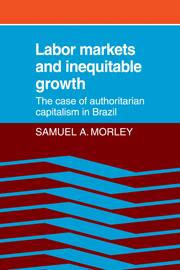
- Cited by 2
-
Cited byCrossref Citations
This Book has been cited by the following publications. This list is generated based on data provided by Crossref.
Nugent, Jeffrey B. and Walther, Robin J. 1982. Short‐run changes in rural income inequality: A decomposition analysis. The Journal of Development Studies, Vol. 18, Issue. 2, p. 239.
Galbraith, James K. and Garza-Cantu, Vidal 2000. Grading the Performance of the Latin American Regimes 1970-1995. SSRN Electronic Journal ,
- Publisher:
- Cambridge University Press
- Online publication date:
- October 2011
- Print publication year:
- 1983
- Online ISBN:
- 9780511896200
- Subjects:
- Economics, Labour Economics, Economic Development and Growth




